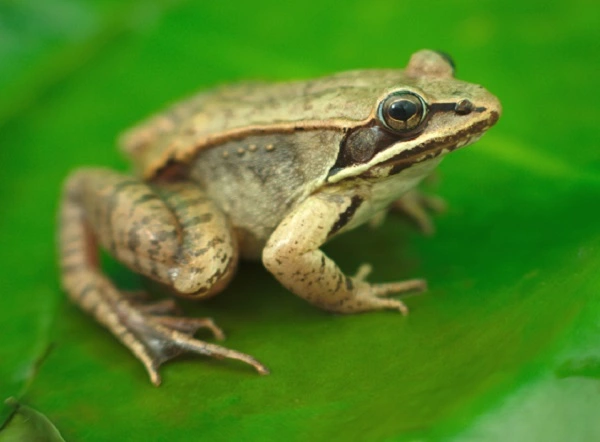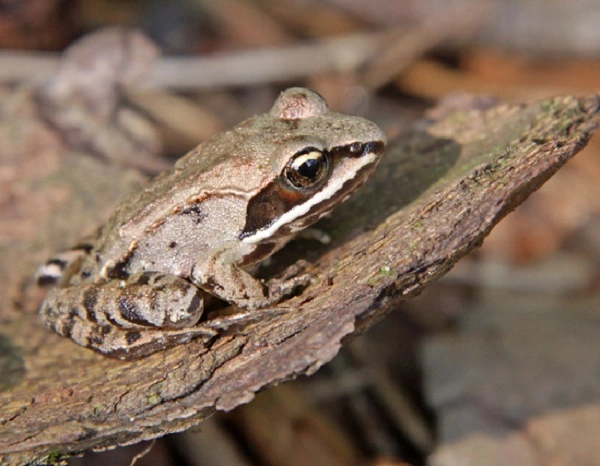The wood frog is a North American amphibian that can be found in abundance in the boreal and temperate forests of Canada and the United States. This frog is unique from other frogs in that it can tolerate freezing temperatures by going into a state of hibernation. In this blog post, we will take a closer look at the wood frog, its biology, habitat, and conservation status.

Wood Frog Description
Wood frogs are small amphibians that are found in North America. They get their name from their habit of spending time in wooded areas. Wood frogs are brown or green in color, and they have dark spots on their backs. They have large hind feet that help them to swim and climb. Wood frogs eat insects and other small animals. Wood frogs breed in the spring. The female lays her eggs in a pool of water. The male fertilizes the eggs. The eggs hatch into tadpoles. Wood frogs grow to be about 2 inches long. Wood frogs can live for up to 8 years in the wild. Wood frogs are endangered because of pollution and loss of habitat. Wood Frogs are an important part of the ecosystem because they eat insects that could damage crops. Wood Frogs also help to control the population of other amphibians by eating their tadpoles.
Wood Frog Habitat
Wood frogs are found in a variety of habitats, including woods, streams, ponds, and marshes. They prefer areas with high humidity and plenty of cover, such as logs or rocks. Wood frogs are most active at night, when they hunt for insects, spiders, and other small animals. During the day, they rest in shady areas or beneath logs or rocks. Wood frogs are good swimmers and climbers, and they can often be found near the water’s edge. Wood frogs are one of the few amphibians that can tolerate cold temperatures. In fact, they are able to survive freezing by producing a substance in their blood that prevents ice crystals from forming. As a result, wood frogs are often the first amphibians to appear in the spring. Wood frogs play an important role in the ecosystem by providing food for predators and helping to control insect populations.
Wood Frog Diet
The Wood Frog is a small amphibian that is found in wooded areas of North America. These creatures have a diet that consists mainly of insects, spiders, and other small invertebrates. Wood Frogs will also consume fruit and berries when they are available. This diet helps to keep the Wood Frog population healthy and ensures that these animals are able to meet their nutritional needs. In addition to their regular diet, Wood Frogs will also consume carrion (dead animals) on occasion. This helps to clean up the forest floor and allows the Wood Frogs to obtain additional nutrients that they would not otherwise have access to.

Wood Frog Size
Wood Frogs are small amphibians that are found in North America. They get their name from their habitat, which is typically wooded areas near ponds or streams. Wood Frogs are also known for their ability to withstand cold temperatures. This is because they have a special type of glycerol that prevents them from freezing when the temperature drops below freezing. Wood Frogs typically range in size from 1.5 to 2.5 inches long. However, they can sometimes grow to be 3 inches long. Wood Frogs are usually brown or tan in color. However, they can also be green, red, or orange. Wood Frogs are not considered to be endangered at this time. However, their populations have declined in some areas due to habitat loss and pollution. Wood Frogs are protected in many parts of the United States and Canada.
Wood Frog Lifespan
Wood Frogs (Rana sylvatica) are a species of frog that is found in North America. Wood frogs get their name from their habitat, which is usually near woods or wetlands. Wood frogs are small frogs, with adults reaching lengths of 2-3 inches. Wood frogs are brown or olive green in color, with dark spots on their backs. Wood frogs are interesting creatures because they have the ability to completely freeze during the winter. Wood frogs will burrow underground and enter a state of hibernation. Their heartbeat will slow down and they will stop breathing. Wood frogs can remain in this frozen state for several months. When the weather warms up, the wood frog will thaw out and return to its normal activity level. Wood frogs have a lifespan of 3-5 years in the wild. Wood frogs are also known to live up to 10 years in captivity.
Wood Frog Behavior
Wood frogs are widely distributed throughout North America and can be found in a variety of habitats, including forests, swamps, and wetlands. Wood frogs are unusual among frogs in that they are able to tolerate freezing temperatures and remain active during the winter months. Wood frogs get their name from their ability to change the color of their skin to match the color of wood. Wood frogs typically mate in early spring and lay their eggs in ponds or shallow pools of water. The tadpoles hatch a few weeks later and undergo metamorphosis into adult frogs by late summer. Wood frogs are opportunistic feeders and will eat a variety of insects, spiders, and other small invertebrates.
Wood Frog Speed
Wood frogs are capable of reaching impressive speeds when necessary. They have long hind legs that they use to propel themselves forward at high speeds. Wood frogs can reach speeds of up to 12 kilometers per hour when they are moving over level ground. When they are moving downhill, they can reach speeds of up to 25 kilometers per hour. Wood frogs are able to move so quickly because they have a number of adaptations that allow them to run efficiently. For example, their hind legs are very powerful and their bodies are covered in a tough layer of skin that helps them to move smoothly through the air. Wood frogs are amazing athletes, and their speed is just one of the many things that makes them so special.
Wood Frog Hunting
Wood frogs are a common sight in many parts of North America. These small, brown frogs are often found in wooded areas near ponds or wetlands. Wood frogs are not particularly active hunters, but they will eat a variety of small insects and other invertebrates. Wood frogs typically hunt at night, using their keen sense of hearing to locate their prey. Once they have found their target, they will use their long, sticky tongue to capture it. Wood frogs are not known to be aggressive towards humans, but they will defend their territory if necessary. Wood frogs generally only live for a few years in the wild, but they can survive for up to 15 years in captivity.
Conclusion
Wood frogs are an interesting animal with some unique features. They can be found in many parts of North America, and they play a vital role in the ecosystem. As more people learn about wood frogs, hopefully they will appreciate these animals for all that they do.
Frequently Asked Question


